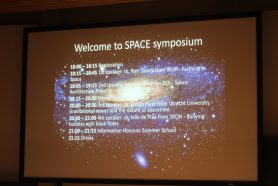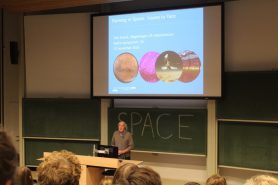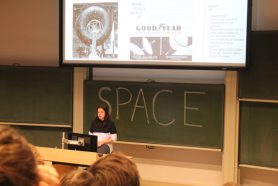News
Space Symposium
On Tuesday 15th of November the first SHA symposium of the year took place, themed Space. It was a great success to choose such an interesting and intriguing topic, because in all times people were interested to learn more about the unknown. It is difficult to find a person who has never looked up at the sky and wondered about what it is, how far it goes, and whether or not there may be others out there who are looking up at them.
The audience was made up of not only astrophysicists, but people from unrelated studies who wanted to broaden their knowledge and understanding of space. The first presentation by Dr. Tom Dueck evaluated possibilities of growing plants in space. Farming in space might be a very good source of fresh food, nutrition and long term food supply for cosmonauts. However, to make farming in space possible it is important to solve the difficulties that arise due to the differences between Earth and Mars in terms of for example radiation and climate. It was determined that 10 times more energy is required to grow 1 kg tomatoes on Mars than on Earth.
During the second presentation, Hanna Lakk talked about different space architecture projects. It was interesting to learn how the designs of different spaceships developed and what are the differences between different countries’ designs. It was fascinating to see the progress of technology and new innovative elements brought to spacecraft architecture. The designs of spaceships as they exist now had to overcome series of changes and remodelling in order to improve its technical characteristics.
Dr. Enrico Pajer presented the very interesting but complicated topic of gravitational waves and the nature of space-time. Gravitational waves are ripples in the fabric of space-time caused by some of the most violent and energetic processes in the Universe. Albert Einstein predicted the existence of gravitational waves in 1916 in his general theory of relativity. Even though it is a very complicated matter and for a non-physicist audience quite challenging, Dr. Enrico Pajer used lots of analogies and visual techniques to make it easier to understand.
The last speaker but not the least was Dr. Jelle de Plaa from SRON Netherlands Institute for Space Research, who talked about blowing bubbles with black holes. Again, a very complicated topic, however the analogy with air bubbles in the water made it a bit easier for the audience to understand the matter. This presentation was followed by a series of question from the audience.
Overall, the event was a great success, because a room packed with people from different studies learned a lot about Space. Many thanks to the speakers, who were able to present such interesting and at the same time difficult topics.






Recent Comments